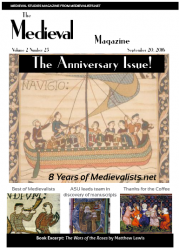Charlemagne ‘Father of Europe’: A European Icon in the Making
By Marianne Ailes
Introduction: Along with the legendary King Arthur and the crusading conqueror of Jerusalem, Godefroy of Bouillon, Charlemagne was one of the three secular ‘chivalric’ Worthies of the later Middle Ages. Arthur and Charlemagne shared the status of legendary Christian kings belonging to a pervious age, but there were major differences between them.
For Charlemagne, unlike Arthur, we have a significant body of factual evidence, documents and chronicles, and, even though some of it must be treated with great care, this gives us considerable knowledge of the emperor’s deeds and reputation. Secondly, whereas Arthur has a particular association with Britain, Charlemagne was ‘emperor of Europe’. At his death in 814, the Emperor Charlemagne ruled over much of what we now call France, Germany, the Low Countries and modern Italy. As his myth developed he became associated with an even more extensive community. that of a united Christendom.
Given the extraordinary achievements of the man Charlemagne, it is not surprising that we find him being celebrated heroically. Within his own lifetime the anonymous poet of Karolus et Leo Papa, otherwise known as the ‘Paderborn Epic’, gave him the epithet ‘Rex, pater Europae; ‘King and Father of Europe’.’ The anonymous poet was not the only contemporary to write about Charlemagne,’ but in this phrase he encapsulated an idea that has since grown wings, in recent decades being appropriated by the European Community: the Charlemagne Building in Brussels houses offices of the European community; the annual Karlspreis is awarded for services to the unity of Europe; there is even a newspaper column about the European Union named after the emperor.’ While the phrase itself, ‘Father of Europe’, may owe more to the Latin education of its writer than to any sense of , Europe’ as a polity in the ninth century, it still suggests a ruler whose reputation had already created a sense of unity which would extend beyond the identity of a single people.
The process of myth-making was not restricted to one context or one kind of writing; it begins with contemporary Latin material, and is developed and disseminated in both Latin and vernacular languages. Any analysis of the making of this image of Charlemagne as ‘father of Europe’ therefore needs to encompass both Latin and vernacular. Throughout the Middle Ages Charlemagne was a central figure (even if not always depicted positively), in the literature of cultures from Iceland to Italy and from Ireland to Eastern Europe. Although he had not ruled this entire that area he was nonetheless celebrated; tales were told about him and statues representing him were erected. He is not, however, treated in the same way in each language and literature of Europe. He is at once a symbol of a united Europe and at the same time is represented differently across different linguistic cultures and/or geographical areas. This article will examine his presentation as a symbol of a united Europe, or Christendom, with regard to his particular appropriation in France and wider francophone culture thus acknowledging that literature in French plays a particular role in the development of the myth of Charlemagne. This presentation will be explored through early Latin accounts of Charlemagne and the earliest vernacular texts extant, early chansons de geste and the related Pseudo-Turpin Chronicle.

